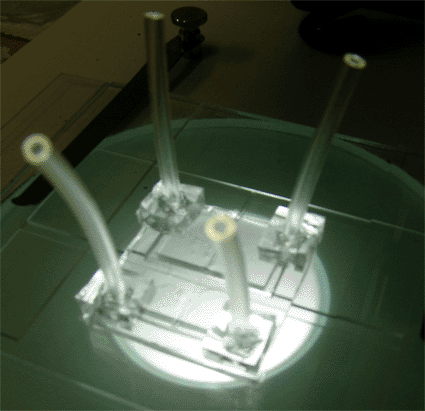Tiny Injector Speeds Development of Newer, Safer Drugs
By LabMedica International staff writers
Posted on 21 Nov 2009
A palm-sized micro-injector could vastly increase preclinical trials for drug development and genetic engineering, and provide greater control of the process. Posted on 21 Nov 2009
Researchers at McMaster University (Hamilton, ON, Canada) developed the automated microfluidic micro-injector, which can insert proteins, DNA, and other biomolecules into individual cells at volumes exponentially higher than current procedures, and at a fraction of the cost. The micro-injector has a cell-wide channel cast on a silicon chip that guides cells and embryos to the injection site. A similar channel guides the injection reagent to a needle as thin as 10 micrometers--one-tenth the diameter of a human hair. A buckling method is used to drive the needle through a cell's pliable outer membrane accurately and to the proper depth. The injection dosage is controlled electrically, as is monitoring of the needle's position. The researchers have also developed methods to sharpen the needle, ensuring minimal injection damage or interference to the cell. Notably absent is the need for a microscope or optical magnification to conduct the process, which is required for manual injection and to monitor transfection methods. The microfluidic device also allows easy integration of postprocessing operations, including cell sorting and the testing of cell viability on the same chip.

Image: Microfluidic micro-injector (Photo courtesy of McMaster University).
"This device is to drug discovery what the assembly line was to the automobile or the silicon chip to information technology,” said lead author Ravi Selvaganapathy, Ph.D., an assistant professor of mechanical engineering at McMaster. "It turns what was a complex, resource-intensive process available to a few into an automated, predictable, reliable, and low-cost system accessible to almost anyone.”
"Almost every researcher would be able to have this device at their disposal in their own labs,” added Professor Selvaganapathy. "The micro-injectors can easily be run in parallel and allow for scientists to test far greater combinations of materials in a much shorter time than current processes. It also makes it more feasible to pursue drug discovery for many so-called neglected diseases.”
The micro-injector also holds great promise for in vitro fertilization (IVF), as it provides far greater accuracy and control than current manual injection procedures, which have high rates of failure, require trained expertise, and can be time intensive.
Related Links:
McMaster University














